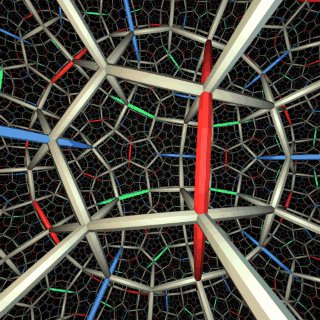All the World is a Series of Ties
When I was fourteen I learnt modular arithmetic at school. The examples we got seemed to come in a pattern. The answers were always 2,8,8, or 2,8,7 etc. This immediately got me thinking about the configuration of electrons in atomic shells. Perhaps, I thought, there was a connection between these two disciplines that would explain the mysterious pattern of the electron configuration once and for all. I later realised that there was no such link - at least not in the way I had envisaged. The relationship between the modular arithmetic examples and the electron configuration had been a mere coincidence (either that or whoever set the maths questions was trying to stimulate or impart some kind information).
At first I tried to reconfigure the Periodic Table so that the electrons count was based on remainder. This meant that a chemical reaction was balanced when the all of the elements summed to 0 (zero). Creating a table based on this method would make matching different stable reactions more easy. But it is hardly what you would call a breakthrough.
From here I went onto learn about the relationship between modular forms and elliptic curves. Elliptic curves sounded like they had more to do with the geometry of the election shells than did modular forms on their own, so I decided to investigate them further. At first I could not find out much about them, but then I watched a video about Fermat's Last Theorem and I saw that elliptic curves have more in common with the doughnut or torus shape than their name might otherwise suggest.
Modular forms and elliptical curves are useful in knot theory, because each individual knot can be expressed as one (and only one) modular form. This makes it easier for scientists and mathematicians to differentiate between very complex knot shapes. Many different kinds of knots can be depicted as windings around a torus or doughnut, and each of these is given a modular value like; 1,2 or 3,2 etc.
In this reproduction of my notes (click to enlarge) we can see the list of the periodic elements on the left, followed by their individual modular value and finally by the whole number elliptic curve value. As we can see H (hydrogen) is denoted by the number 1; meaning that it needs one electron to form a stable bond. Next we have Helium, which is stable and as such looks like a closed loop around the torus; See fig. 1 below.
Fig. 1; The closed loop around this torus represents the stable
electron configuration of Helium (Torus Knot: 1,2).
Lithium has three electrons, two of which are bonded and stable. The third loose electron is what makes this a highly reactive and to some extent unstable element. An elliptic representation of this element is as follows; (See fig. 2)
Fig. 2; This is the most common mathematical depiction of elliptic
curve geometry on the Internet. It shows a closed loop next to a
line stretching off into infinity. The second line can also be thought of
as a loop because its ends meet at infinity. According to my theory
of electron configurations this is an accurate depiction of
Lithium (Torus Knot: 1.5, 2).
Next we have Berilium. Berilium has four electrons and is therefore more or less stable. This could be depicted as two closed rings around the elliptic plane, but I believe a more accurate and fluid example is shown below in fig. 3.
Fig 3; Outer shell of Berilium
(Be; Mod 4, Torus Knot; 1, 2)
Fig 4: Outer shell of Oxygen
(O; Mod 0, Torus Knot 3,2)
Fig 4: Outer shell of Iron
(Fe; Mod 2, Torus Knot 4,2)
Fig 5; Outer shell of Nickel
(Ni; Mod 0, Torus Knot 5,2)
Next, lets take a look at how chemical bonds might be formed under this model. The example below (fig. 6) shows two Lithium atoms coming into close contact with one another. The two lines which represent the unbonded electrons begin to join energetically at infinity and draw one another closer together.
Fig 6; Two lithium atoms in close proximity.
Eventually they do join creating the well known form of the double torus (fig 7) to create 2Li.
Fig 7; 2 lithium atoms bonded.
It stands to reason that if a simple chemical bond like the one above (fig. 7) can take the form of a double torus, then a slightly more complex one, like 3 Aluminium atoms for example, might take the shape of a triple torus.
The triple torus shape is closely related to the Klein Quadratic, and many other automorphic linear groups that have a distinct relationship to the structure of time.
However, there are important differences between my model and theirs. For instance, the PSI website depicts the electrons as discrete particles that follow their own individual paths around the toroid, whereas mine shows that the electrons all follow the same twisting path in the manner of a waveform. Waveforms (and therefore modular forms) are an important part of understanding electron shells, and should not be left out or forgotten.
From a structural point of view it is also important to note that the different electron shells, and therefore the different elliptic curves are nested one within the other, and that they share a common centre of symmetry with protons in the nucleus.
What the Modular theory of electron bonding and configuration tells us is that chemical bonding is akin to the knots of knot theory. Every knot has a unique modular form associated with it, known as its link compliment (or fundamental domain). These fundamental domains may be useful in building models of complex chemical compounds or reactions, and lead to the discovery of new kinds of materials in the future.


















































